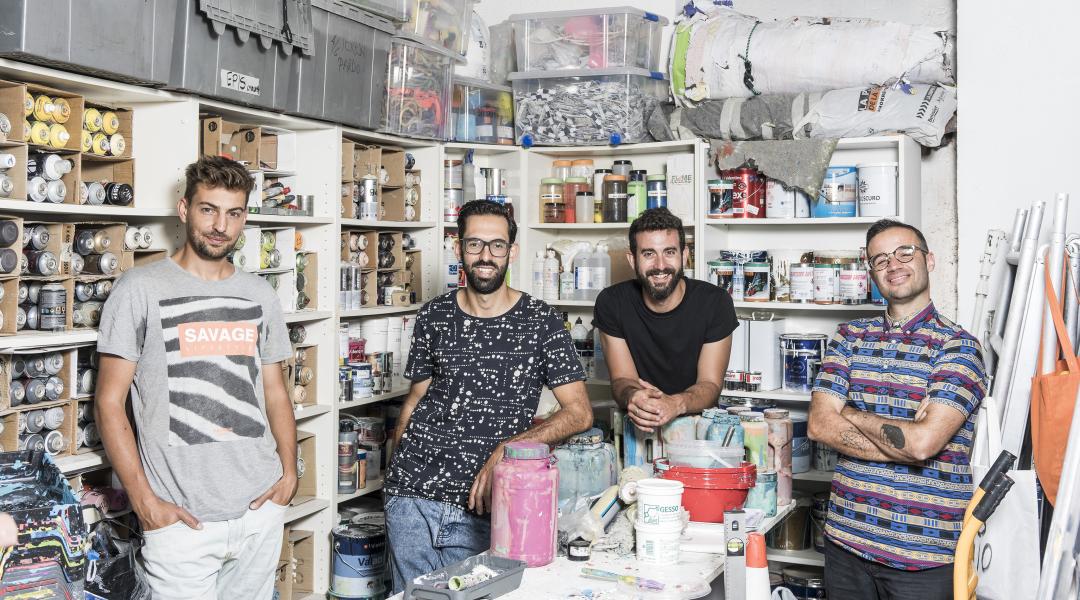Boa Mistura
Social Art Takes The Streets

Their work decorates the streets of cities such as Berlin, New Delhi, Panama and São Paulo. For Boa Mistura, art is participative—both the place and its neighbours have a say because they believe in resident’s critical and human capacity.
If you live in Madrid, chances are you have looked down zebra crossings on more than one occasion to read verses such as Que la ciudad sea contigo (May the city be with you) or Esta guerra se gana bailando (This war shall be won by dancing). This is just one of the many and very special projects carried out by Boa Mistura, an art collective whose work adorns the streets of several cities around the world including Berlin, New Delhi, Panama, and São Paulo.
Their penchant for Brazilian graffiti—much more creative in their opinion than the one made in the United States— led this group of friends from Madrid’s district Alameda de Osuna who met in the late nineties while painting graffiti, to choose the name Boa Mistura (Good Mix) in tribute to Brazil. "Over the years, the name has become premonitory because the mix we are ourselves plus the fusion with people who experience our work is now written in stone in what we do", say current members Javier Serrano, Juan Jaume, Pablo Ferreiro and Pablo Purón.
What sets Boa Mistura apart, making them easily recognizable, is their open creative process, unusual in urban art. Their work revolves around the place where it is created—it is based on dynamics put forward by locals, providing the artists with keys to start working. "Participatory processes are not so common in art, at least not until now, since art is something that usually originates from the artist," they point out.
Art is a human and social need, a cross-cutting and free practice subjected to no ideology, race or religion
This is something they have reflected in some of the works that most impact have had on them, such as their trip to South Africa in 2010, which changed their lives humanly and artistically. "It was the first time we left our comfort zone and worked in a depressed community, and also the first time we created a participatory process, the foundation stone of what we are today." Another highlight in their career were the two weeks they spent in the São Paulo favela of Vila Brâsilàndia, where they realised everything they had learned in South Africa actually worked. They also have really fond memories of Mulafest, a Madrid urban trends festival they consider “family because they had us in several editions; in 2013 they supported us by funding a project at Algier’s Kasbah, which wasn’t something very common back then. That left a mark because we wouldn’t have been able to do it without them, so Mulafest is part what we are."
For Boa Mistura, art is a human and social need, a cross-cutting and free practice subjected to no ideology, race or religion. It a critical and emotional quality, which is essential for human beings. “This kind of freedom makes it the most powerful tool to emphasize certain aspects of the world we live in, whether critically or with the aim to humanize them, beautify them or just laugh at them." For them, an artless society is a sick society. They recall “someone from our neighbourhood saying: a doctor’s job is to heal the body; a mechanic’s to fix cars; an artist’s to touch people’s souls. We actually feel the same”.
Boa Mixtura admire the work of fellow artists Spy, Ampparito, E1000, Aryz, JR, Elian Chali, Escif and Axel Void, as well as other art collectives like Basurama and Domestic Data Streamers. They have an open mind when it comes to showing their enthusiasm for creators from other fields, for example architecture studio RCR, writer Benjamín Prado, singer-songwriter Joaquín Sabina and film director Romain Gavras: “There are always creators to admire in any artistic discipline”.
If you ask them for a huge name in urban art, the answer is Banksy: “He is a genius. Everything his work has generated is an example of the absurdity pervading some areas of society”. Boa Mistura thinks “art in the public space is free. It is made in the streets to reach passers-by, whether they aim to see it or not. No tariffs apply. The very fact that it is free leads many to want to own it, to privatize it and use it for their own interests. Some pieces mock or criticize the very same system that is speculating with them. The circus created around Banksy invites us to reflect on many issues—how urban art relates to the public space, how society relates to it, where to place ownership…”.
And from reflection to reality. Boa Mistura has just finished an over 7,000 square-metre project in Polígono de La Paz, a stigmatized neighborhood in Murcia. This summer they will be in Rivas Vaciamadrid, in the Modelo prison in Barcelona, and in Oliete, a small town in Teruel. "Afterwards will be go the US, to Salem and Atlanta, and we will focus on big projects slated for 2020. There are many miles of rock & roll ahead of us."




